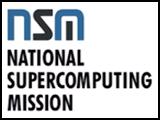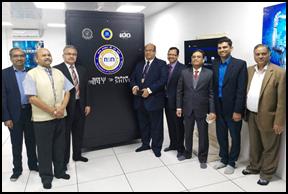[ad_1]
Ministry of Electronics & IT

National Supercomputing Mission
Powering India’s Future with Indigenous High-Performance Computing
Posted On:
28 APR 2025 6:00PM by PIB Delhi
“India’s mantra is Atmanirbharta through research, Science for Self-Reliance.”
– Prime Minister Narendra Modi
Introduction

The National Supercomputing Mission (NSM) is a flagship initiative by the Government of India to empower the country with high-performance computing (HPC) capabilities. Launched in 2015the mission aims to enhance India’s technological prowess in supercomputing, foster research and development (R&D), and support scientific advancements across academia, industry, and government sectors.
The Mission envisages empowering our national academic and R&D institutions spread over the country by installing supercomputers of various capacities. Access to these supercomputers is provided through the National Knowledge Network (NKN). The NKN is another program of the government which connects academic institutions and R&D labs over a high-speed network.
Academic and R&D institutions as well as key user departments/ministries would participate by using these facilities and develop applications of national relevance. The Mission also includes development of highly professional High-Performance Computing (HPC) aware human resource for meeting challenges of development of these applications. HRD activities in this area are steered through five training centres at Pune, Kharagpur, Chennai, Palakkadand Goa to expand the awareness and familiarization of supercomputing with college students and researchers.
Current Status & Achievements
Under NSM, as of March 2025a total of 34 supercomputers with a combined compute capacity of 35 Petaflopshave been deployed across various academic institutions, research organizations, and R&D labs, including prominent institutions like IISc, IITs, C-DAC, and other institutions from Tier-II and Tier III cities of the country under NSM. The supercomputing systems commissioned under NSM have achieved an overall utilization rate of over 85%, with many systems exceeding 95%, demonstrating a high level of usage and efficiency in their computational capacity
The contribution of these supercomputing systems to the Research and Development (R&D) sector has been highly impactful, facilitating over 10,000 researchersincluding more than 1,700 PhD scholars from over 200 academic institutions and R&D labs across the country. These supercomputing systems have supported research in critical domains such as Drug Discovery, Disaster Management, Energy Security, Climate Modeling, Astronomical Research, Computational Chemistry, Fluid Dynamics, and Material Research. NSM has created opportunities for researchers from Tier II and Tier III cities to conduct research by providing access to state-of-the-art supercomputing facilities. These researchers have completed over 1 crore compute jobs and published more than 1,500 papers in leading national and international journals. Additionally, more than 22,000 individuals have been trained in HPC and AI skills. Start-ups and MSMEs are leveraging these supercomputing resources to advance their HPC-driven projects.

In parallel, under the NSM, C-DAC has developed the indigenous high-speed communication network, “Trinetra,” to enhance data transfer and communication between computing nodes, strengthening India’s supercomputing capabilities. Trinetra is being implemented in three phases: Trinetra-Poca proof-of-concept system to validate key concepts; Trinetra-A (100 Gigabits per second), a network with advanced connections, successfully deployed and tested in the 1PF PARAM Rudra at C-DAC Pune; and Trinetra-B (200 Gigabits per second), an upgraded version with improved capabilities, set to be deployed in the upcoming 20PF PARAM Rudra supercomputer at C-DAC Bangalore.
In 2024the Prime Minister dedicated three PARAM Rudra supercomputers to the young researchers, scientists and engineers of nation facilitating advanced studies in physics, earth sciences, and cosmology. These supercomputers have been deployed in Pune, Delhi and Kolkata to facilitate pioneering scientific research. PARAM Rudra supercomputers are built using indigenously designed and manufactured HPC servers, known as “Rudra”, along with an indigenously developed system software stack. “Rudra” Server is the first of its kind in India which is at par with globally available other HPC class Servers.

The Government has initiated a project Airawat for providing a common compute platform for AI research and knowledge assimilation. This AI computing infrastructure will be used by all Technology Innovation Hubs, research labs, scientific community, industry, start-ups and institutions under the NKN. The Proof of Concept (PoC) for AIRAWAT will be developed with 200 petaflops mixed precision AI machine which will be scalable to a peak compute of 790 AI petaflops. The AIRAWAT has secured 75th position in Top 500 Global Supercomputing List declared at International Supercomputing Conference (ISC 2023), Germany putting India on top of AI Supercomputing nations worldwide.
In 2022, Indian Institute of Science (IISc), Bengaluru has installed Param of the rightone of the most powerful Indian supercomputers. Param Pravega having a supercomputing power of 3.3 petaflopsis the largest supercomputer that has been installed in an Indian academic institution.
In 2019the Prime Minister inaugurated National Supercomputing Mission’s first indigenously Build Supercomputer ‘Param Shivay’ at Indian Institute of Technology, BHU, Varanasi.
In 2024-25additional ~45 PF of computing infrastructure creation is envisaged using indigenously developed server and technologies.
NSM Infrastructure
The National Supercomputing Mission aims at achieving the goals of attaining self-reliance in supercomputingbuilding the culture of using supercomputing for carrying out R&D and problem-solving in various domains of scientific and technological endeavours, and designing solutions for various societal applications, and positioning the supercomputing ecosystem in the country at a globally competitive level. The systems and facilities created as part of the infrastructure under this mission are divided into three phases: Phase I, Phase II, and Phase III.
Phase 1: This phase focused on creating a basic supercomputing infrastructure by installing six supercomputers across various institutions, with a significant portion of the components being assembled domestically. The aim was to build an ecosystem for the assembly of system components within the country.
Phase 2: Building on Phase 1, this phase aimed to move towards indigenous manufacturing of supercomputersincluding developing a local software stack. This phase also saw an increase in the value addition from India to 40%.
Phase 3: This phase focuses on complete indigenization of supercomputingincluding the design, developmentand manufacturing of key components within India. The plan includes installing supercomputers at various academic and research institutions, as well as establishing a national facility with a high-performance computing capability.
The Mission is being steered jointly by the Department of Science and Technology (DST) and Ministry of Electronics and Information Technology (MeitY) and implemented by the Centre for Development of Advanced Computing (C-DAC), Pune and the Indian Institute of Science (IISc), Bengaluru. The Mission implementation would bring supercomputing within the reach of the large scientific & technology community in the country and enable the country with a capacity of solving multi-disciplinary grand challenge problems.
NSM has planned to expand the number of supercomputers to select institutions including IITs with more compute power including 20 Peta Flop systems. An amount of Rs. 1874 crore has been allocated / utilized to develop and provide the super-computing facility for research and other allied areas. This includes funds for infrastructure creation, undertaking R&D in applied areas, applications, HRD and for mission management.
Strengthening NSM through India Semiconductor Mission (ISM)
The India Semiconductor Mission (ISM) is set to give a big boost to the National Supercomputing Mission (NSM). Supercomputers need powerful parts like processors, memory chips, and special accelerators — all of which are made using advanced semiconductor technology. Until now, India had to rely heavily on imports for these components.
With ISM, India is focusing on making these high-tech parts right here at home. This will make supercomputers faster, more energy-efficient, and much more affordable. It will also allow India to build supercomputers that are customized for our own scientific and industrial needs. By developing these technologies within the country, ISM will help NSM move closer to its dream of making India self-reliant and a global leader in supercomputing.
Conclusion
The National Supercomputing Mission is a transformative initiative that strengthens India’s position in global supercomputing. By fostering indigenous development, research, and innovation, NSM supports critical sectors and prepares the nation for future technological challenges. With continued investment and strategic deployment, India is poised to become a global leader in High-Performance Computing.
References
https://pib.gov.in/PressReleasePage.aspx?PRID=1666447
https://pib.gov.in/PressReleasePage.aspx?PRID=2081061
https://pib.gov.in/PressReleasePage.aspx?PRID=1800356
https://dst.gov.in/pm-launches-country-1st-indigenously-build-supercomputer
https://pib.gov.in/PressReleseDetailm.aspx?PRID=2087506
https://pib.gov.in/PressReleasePage.aspx?PRID=2088268
https://sansad.in/getFile/loksabhaquestions/annex/184/AU2084_k8K63G.pdf?source=pqals
https://sansad.in/getFile/annex/267/AU3905_rZLY5P.pdf?source=pqars
National Supercomputing Mission
***
The Century Santis | Following Meena | Richite
(Release ID: 2124920)
Visitor Counter : 36
[ad_2]
